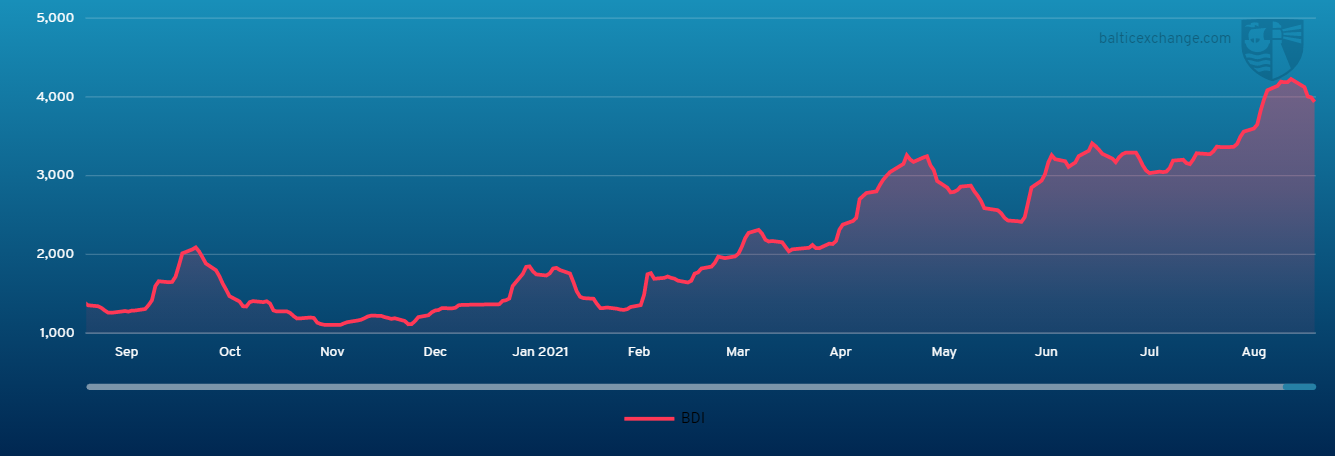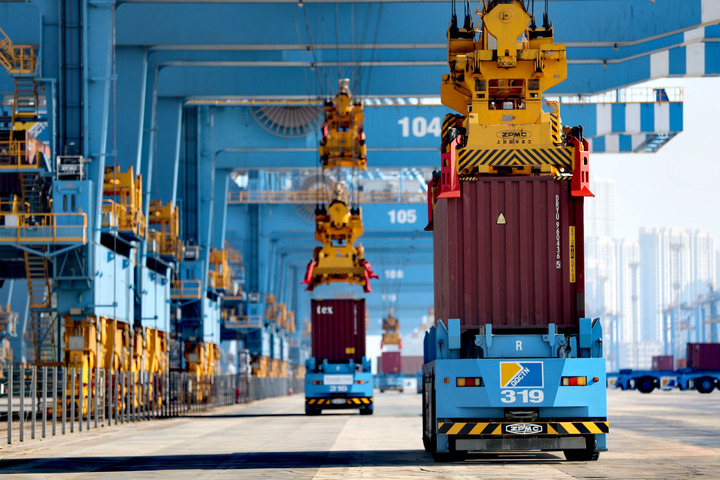BEIJING, Sept. 6 (Xinhua) -- The Baltic Exchange has published its weekly report of the dry and tanker markets for Aug. 30-Sept.3, 2021 as below:
Capesize
The Capesize market crested over the past week as the 5TC retracted $4,452 since last Friday to close out at $46,647. The north Atlantic basin, largely inactive over the past several months, has surged since mid-August settling today at $52,099 on the Transatlantic C8 and $79,600 on the Fronthaul C9. The fronthaul route has been particularly volatile with large swings between days for tonnage taking cargo back to the far east. Further south the Brazilian market to China eased throughout the week, now largely on par with value for tonnage in the Pacific basin. The voyage route Brazil to China C3 reduced 2.605 to close at $33.165.
In the Pacific the market was active with numerous coal and iron ore perspectives, yet the West Australia to China C5 lowered 1.282 to $13.668 as ample tonnage options were heard in the region. While the Capesize market retraced its steps slightly this week earnings overall remain robust and healthy for owners as we sail into the traditional high earning season for the sector.
Panamax
The Panamax market saw substantial corrections this week, particularly in the Atlantic as pressure was applied all week with a basic lack of demand especially for the Transatlantic trades. Conversely, Asia witnessed strong cargo volumes from all three major origins Australia/NoPac/Indonesia which proceeded to keep rates well balanced. However, nervousness both from the Atlantic physical and FFA market appeared to impact the basin here too as we approached the weekend. An 82,000dwt delivery Thailand was reported to have agreed a rate of $35,500 for a trip via EC South America redelivery Far east, otherwise limited trades were reported from South America.
In the Pacific, an 82,000dwt delivery China fetched $37,000 for a trip via NoPac redelivery Singapore-Japan range, whilst an 82,000dwt delivery Philippines agree a rate of $37,000 for a trip via Indonesia redelivery China. Period activity was scarce but did include reports of an 82,000dwt achieving $27,000 for roughly 10-12 months employment.
Supramax
A week of falls across most routes led to the BSI closing at 3,348, a drop of 122 week-on-week. With Hurricane IDA the US Gulf lost momentum as cargo supply eased, whilst from South America fresh enquiry was limited. From Asia, an easing of congestion from China saw tonnage availability increase, giving charterers greater flexibility. Overall, period activity was limited, with a 63,000dwt open south China fixing four to six months trading at $41,000. From the Atlantic a 58,000dwt was heard fixed delivery east coast South America trip to Bangladesh at $25,000 plus $1,475,000 ballast bonus. Further north, a 63,000dwt was fixed for a trip from north coast South America to India at $49,000. From Asia, a 63,000dwt open Cebu was fixed for a trip to east coast India-Bangladesh at $43,000. For Pacific round voyages a 63,000dwt open South Korea was failed for trip via Australia redelivery Singapore-Japan at $40,000.
Handysize
In contrast to last week BHSI lost ground overall as areas such as the US Gulf and east coast South America saw rates ease as demand fell. Similarly, from the Asian arena rates eased with limited fresh enquiry coming into the market, leading to a larger amount of prompt tonnage. Limited period activity was seen, but a 33,000dwt was recently fixed from north coast South America for three years trading at $17,000. A 33,000dwt open Algeria was also heard to have fixed five to seven months trading redelivery Atlantic at around $34,500.
From the US Gulf pressure eased a 38,000dwt fixing at around $22,000 for a trip to the Continent. From the east Mediterranean a 32,000dwt was fixed delivery Canakkale for a trip to west Africa at $42,000. From Asia limited activity was heard as brokers said cargo activity dropped off with owners looking to the upcoming week to see if this trend would change direction.
VLCC
There were a few spot market deals and more contract of affreightment fixtures this week which has had a slightly positive impact on market rates in the Middle East Gulf region. The rate for 280,000-mt to US Gulf (routing via the Cape/Cape) remains steady at the WS18 mark, while 270,000-mt to China saw about a two-point gain to just shy of WS34 (a round trip TCE of $-2,000 per day).
In the Atlantic, despite a lack of reported fixing activity, rates for a 260,000-mt West Africa to China modestly improved by half a point to WS34-34.5 level (a round trip TCE of $-350 per day). A 270,000-mt US Gulf to China marginally rose $6,000 to $3.97 million although Vitol is reported to have taken a modern Omani vessel (recently employed for the carriage of clean petroleum products) at $3.95 million.
Suezmax
In West Africa the short week has stifled the recent gains and rates have dipped slightly. A 130,000-mt Nigeria/UK Continent is now worth WS55 (a round trip TCE of almost $2,000 per day), two points less than a week ago. Rates for 135,000-mt Black Sea/Mediterranean eased 1.5 points to WS62 (a TCE round trip of $-4,400 per day). The Middle East market was again quiet this week with rates for 140,000-mt Basrah/Mediterranean holding at the WS25-26 level.
Aframax
In the Mediterranean, an 80,000-mt Ceyhan/Lavera remains at the WS87.5 mark (about $2,000 per day TCE roundtrip) while in Northern Europe 80,000-mt Cross-North Sea held at the WS92.5-93 region (a round trip TCE of $-4,700 per day) and rates for 100,000-mt Baltic/UK Continent were stagnant at the WS59-60 level (a TCE of about $-2,000 per day round trip). Across the Atlantic, the market has seen a bad weather induced improvement with rates for 70,000-mt Caribbean/US Gulf between WS105-107.5 (a TCE of $6,4000 per day round trip) and 70,000-mt East Coast Mexico/US Gulf fixing a good number of times, rising 30 points to WS112.5 (a round trip TCE of $9,600 per day).
Rates for 70,000-mt US Gulf/UK Continent have also seen a climb, up 13 points week-on-week to WS92.5-95 level (a TCE of $5,000 per day round trip, which improves significantly for a one-way trip).
Clean
The Middle East Gulf has seen continued activity this week on all sizes. LR2s to Japan (TC1) have risen another five points to WS115, a round-trip TCE of $12,518 a day. The LR1's have readjusted as ship availability has increased this week and TC5 55k Middle East Gulf/Japan now in the WS125 region, a round-trip TCE $11,500 a day. The MR 35k Middle East Gulf/East Africa (TC17) has had consistent momentum this week from high demand in the region. Freight rates have subsequently risen by 21 points to WS222, a round-trip TCE of $15,435 a day.
The Mediterranean Handy market has seen rates erode further this week due to an oversupply of tonnage in the region and TC6 30kt Skikda/Lavera is now at WS112.5 (-WS2.19). The LR2's still remain to be properly tested following the LR2 activity in the Middle East this week, TC15 80k Mediterranean/Japan currently marked around $1.7 million.
A much-needed boost in the Baltic Handy market this week and rates have surged from an influx of new enquiry and a lack of vessels in the region. TC9 30k Baltic/UK-Continent rose to WS143.57 (+ WS23.57). On the UK-Continent MR freight levels have tumbled. The TC2 37k UK-Continent / US Atlantic Coast is now at WS109.17 (down WS6.39), showing a round-trip TCE of $1,713 a day. There are reports of lower freight levels expected shortly with more vessels ballasting over from the USA. TC19 37k Amsterdam to Lagos has unavoidably followed suit and is now WS114.17 (down WS8.33).
On the LR1s, TC16 60k Amsterdam/Offshore Lomé levelled out at the WS85 mark following an incremental rise to WS87.5 in the middle of the week.
In the Americas rates have continued to degrade due to liquidity being thin in the region this week, a result of Hurricane Ida, and there are not many signs of this changing in the short term. TC14 38k US Gulf/UK-Continent route now at WS60 (-WS13.57) and TC18 35k from US Gulf/Brazil, correlated accordingly to end up at WS95.42 (down W8.75).
The MR Atlantic basket TCE dropped from $4,695 a day to $2,019 a day.
Headquartered in London and a subsidiary of the Singapore Exchange (SGX), the Baltic Exchange publishes a range of indices and assessments which provide an accurate and independent benchmark of the cost of transporting commodities and goods by sea. These include the Baltic Dry Index (BDI), the dry bulk shipping industry's best known indicator. Published daily since 1985, this provides a snapshot of the daily spot market earnings of capesize, panamax and supramax vessel types on the world's key trading routes.

Chart shows Baltic Dry Index (BDI) during Sept. 3, 2020 to Sept. 3, 2021

Baltic Forward Assessment for BDI
In March 2018 the BDI was re-weighted and is published using the following ratios of time charter assessments: 40 percent capesize, 30 percent panamax and 30 percent supramax. The information is provided by a panel of international shipbrokers.
(Source: The Baltic Exchange, edited by Niu Huizhe with Xinhua Silk Road, niuhuizhe@xinhua.org)




 A single purchase
A single purchase









